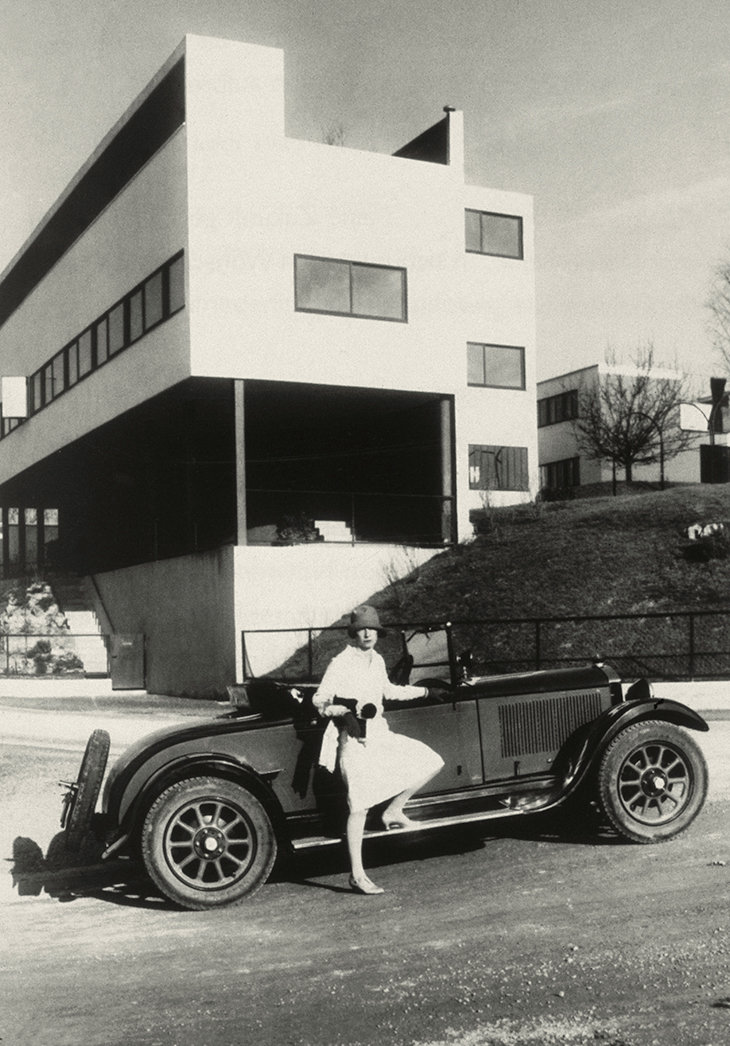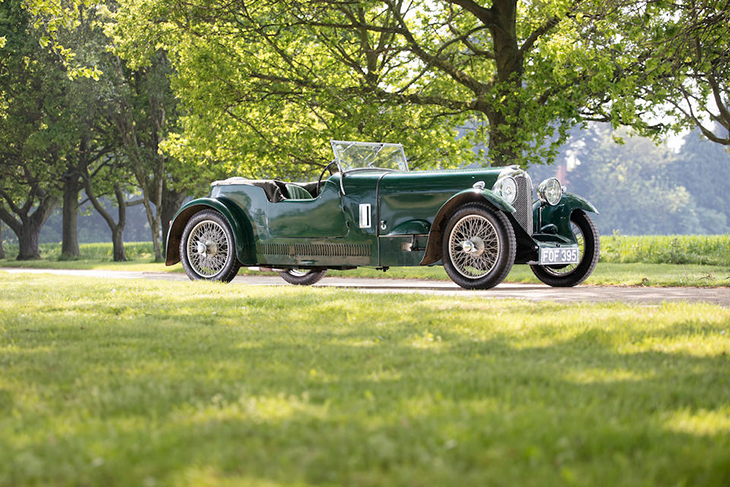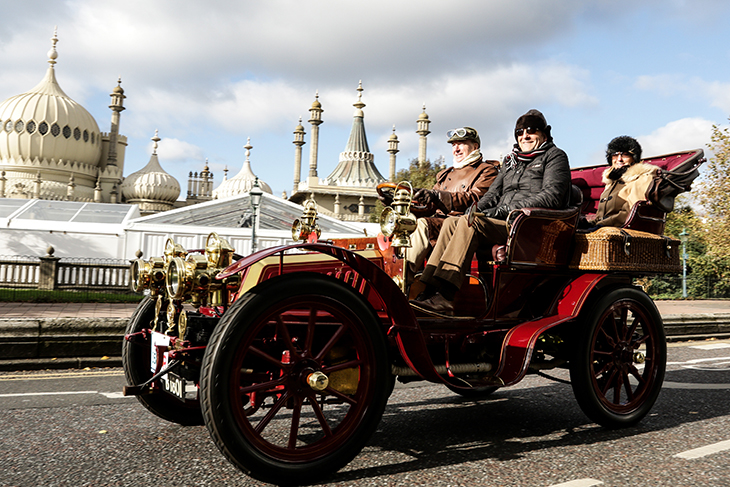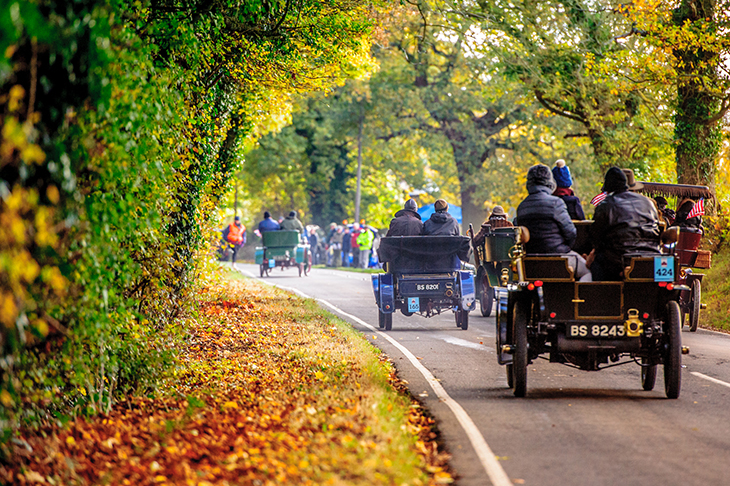The black-and-white photograph shows a woman dressed in a pale shift dress. Her cloche hat is low on her brow and she has one knee bent, her foot on the running board of a motorcar as though she were about to hop in and zoom off. You can almost smell the zephyr of petrol. The car, racing green perhaps, looks almost exactly contemporaneous to the building it stands in front of: Le Corbusier and Pierre Jeanneret’s thrusting duplex in Stuttgart’s Weissenhof Estate, completed in 1927.

Woman posing by a motorcar at the Weissenhof Estate in Stuttgart, 1927. Photo: akg-images
Some might think they recognise the description – it reads like a well-known image in some architectural circles. But no. For the woman in this particular picture is wearing trainers. The date is not 1927, but 2019. She is no modernist mondaine, but my father’s (certainly fashionable) partner. And the car is not German, but a Marendaz Special, built in Berkshire in 1936.
The Special made up a four-strong cavalcade of classic cars we drove across mainland Europe to celebrate my father’s 60th birthday two years ago. The others were of similar standing if not style or vintage: a 1967 Fiat Dino Spider, a 1976 Jaguar XJ6 Coupe and a Maserati Khamsin of 1979. Our route was plotted with architectural points of interest in mind, from Reims cathedral to the infernal Völklingen ironworks, on Germany’s French border.

A 1936 Marendaz Special 13/70hp Sports Tourer. Photo courtesy Bonhams
We were, across the fortnight, at the mercy of the machines we drove. Parts of the itinerary were missed completely, replaced by impromptu (read: involuntary) roadside picnics, as we waited for overheating engines to cool (or even, at one point, stop flaming). It would have been a shame, had we not quickly realised that our movement through shifting scenery – and our engagement with that movement – was, in fact, always the point of the trip.
Cars such as these are as bolshy as they are beautiful. Those preparing for the London to Brighton Veteran Car Run, which celebrates its 125th birthday this month, will know this better than most. All cars taking part in this 54-mile race – inaugurated in 1896 to celebrate the Locomotives on Highway Act, which increased the speed limit from 4mph to 14mph – must have been built before 1905: the contraptions of ‘glittering plate-glass and rich morocco’ that caught the crazed eye of Mr Toad, the original petrol-head. They are all chug and poop and trundle. They have mighty wills and strong personalities. It’s no surprise, really; in the early 20th century, cars were almost entirely experimental – horse-drawn carriages without the horse, fitted instead with internal-combustion engines.

Participants in the London to Brighton Veteran Car Run driving past Brighton Pavilion
Fifty years later, manufacturers were still working things out – how many gears was optimal, on which side the indicator lever should go. Take the Dino Spider. Its long, sleek silhouette and quietly muscular build were the brainchild of the Italian design firm Pininfarina; its roaring V6 engine came courtesy of Ferrari, which wasn’t able to manufacture the cars quickly enough and handed the job over to Fiat. It is an enchanting car, but it takes at least eight pumps of the throttle to get its six cylinders primed and the engine to start. While it is positively newfangled in comparison to those running to Brighton, what links classic cars with veteran ones is their status as mobile museum pieces, albeit ones that a few lucky people get to handle, play with and use. White gloves are swapped for leather driving gauntlets – though of course when not on the road the cars are stored, cleaned and cared for as carefully as any painting or sculpture.
As with us, the personalities of these earlier machines are comprised of countless quirks. To drive them is to negotiate with those traits, through levers, buttons and switches, using our own, human, mechanics to wrangle with theirs. Modern cars, on the other hand, have been designed to feel almost like we are not driving. They are electrified easy chairs set in chassis, controlled by dozens of chips. The experience is remote rather than immersive. The appeal of old cars is precisely that immersion, that rawness. There’s a thrill in trying to drive these things (and try you really must). Anyone who has felt the buzz of mountaineering in the rain or swimming in freezing water will recognise it. As will anyone who has navigated a 1903 Haynes-Apperson down the A23. The closer you get to the veteran cars built before World War I, the more primal it gets.
Old cars provide us with a profoundly tangible opportunity to reach back into a lost age, to contact people that came before. Lovers of these cars are romantically compelled to try and understand the experiences of our ancestors, just as my father’s partner was doing in that photograph, or the rally drivers in the Veteran Run. It isn’t trite; it isn’t grown-ups playing dress-up. It is an attempt to make contact with the past. We do it all the time with wallpaper and classical furniture and reproduction vinyl records from the 1960s. This is just another form.

The London to Brighton Veteran Car Run
As we do with great buildings, like that modernist masterpiece in Stuttgart, we should conserve, repair and respect these pieces of engineering and design history. The London to Brighton run allows for exactly that. In doing so, it passes on the stories of such atavistic encounters to new generations. These beautiful machines – like all examples of human ingenuity and creativity – are torches, lighting up the corridors of the past. They show us where we’ve come from, in order that we can plot where we are going. And what a road trip that is.

Poetry in motion – a guide to racing antique cars
Participants driving over Westminster Bridge at the London to Brighton Veteran Car Run
Share
The black-and-white photograph shows a woman dressed in a pale shift dress. Her cloche hat is low on her brow and she has one knee bent, her foot on the running board of a motorcar as though she were about to hop in and zoom off. You can almost smell the zephyr of petrol. The car, racing green perhaps, looks almost exactly contemporaneous to the building it stands in front of: Le Corbusier and Pierre Jeanneret’s thrusting duplex in Stuttgart’s Weissenhof Estate, completed in 1927.
Woman posing by a motorcar at the Weissenhof Estate in Stuttgart, 1927. Photo: akg-images
Some might think they recognise the description – it reads like a well-known image in some architectural circles. But no. For the woman in this particular picture is wearing trainers. The date is not 1927, but 2019. She is no modernist mondaine, but my father’s (certainly fashionable) partner. And the car is not German, but a Marendaz Special, built in Berkshire in 1936.
The Special made up a four-strong cavalcade of classic cars we drove across mainland Europe to celebrate my father’s 60th birthday two years ago. The others were of similar standing if not style or vintage: a 1967 Fiat Dino Spider, a 1976 Jaguar XJ6 Coupe and a Maserati Khamsin of 1979. Our route was plotted with architectural points of interest in mind, from Reims cathedral to the infernal Völklingen ironworks, on Germany’s French border.
A 1936 Marendaz Special 13/70hp Sports Tourer. Photo courtesy Bonhams
We were, across the fortnight, at the mercy of the machines we drove. Parts of the itinerary were missed completely, replaced by impromptu (read: involuntary) roadside picnics, as we waited for overheating engines to cool (or even, at one point, stop flaming). It would have been a shame, had we not quickly realised that our movement through shifting scenery – and our engagement with that movement – was, in fact, always the point of the trip.
Cars such as these are as bolshy as they are beautiful. Those preparing for the London to Brighton Veteran Car Run, which celebrates its 125th birthday this month, will know this better than most. All cars taking part in this 54-mile race – inaugurated in 1896 to celebrate the Locomotives on Highway Act, which increased the speed limit from 4mph to 14mph – must have been built before 1905: the contraptions of ‘glittering plate-glass and rich morocco’ that caught the crazed eye of Mr Toad, the original petrol-head. They are all chug and poop and trundle. They have mighty wills and strong personalities. It’s no surprise, really; in the early 20th century, cars were almost entirely experimental – horse-drawn carriages without the horse, fitted instead with internal-combustion engines.
Participants in the London to Brighton Veteran Car Run driving past Brighton Pavilion
Fifty years later, manufacturers were still working things out – how many gears was optimal, on which side the indicator lever should go. Take the Dino Spider. Its long, sleek silhouette and quietly muscular build were the brainchild of the Italian design firm Pininfarina; its roaring V6 engine came courtesy of Ferrari, which wasn’t able to manufacture the cars quickly enough and handed the job over to Fiat. It is an enchanting car, but it takes at least eight pumps of the throttle to get its six cylinders primed and the engine to start. While it is positively newfangled in comparison to those running to Brighton, what links classic cars with veteran ones is their status as mobile museum pieces, albeit ones that a few lucky people get to handle, play with and use. White gloves are swapped for leather driving gauntlets – though of course when not on the road the cars are stored, cleaned and cared for as carefully as any painting or sculpture.
As with us, the personalities of these earlier machines are comprised of countless quirks. To drive them is to negotiate with those traits, through levers, buttons and switches, using our own, human, mechanics to wrangle with theirs. Modern cars, on the other hand, have been designed to feel almost like we are not driving. They are electrified easy chairs set in chassis, controlled by dozens of chips. The experience is remote rather than immersive. The appeal of old cars is precisely that immersion, that rawness. There’s a thrill in trying to drive these things (and try you really must). Anyone who has felt the buzz of mountaineering in the rain or swimming in freezing water will recognise it. As will anyone who has navigated a 1903 Haynes-Apperson down the A23. The closer you get to the veteran cars built before World War I, the more primal it gets.
Old cars provide us with a profoundly tangible opportunity to reach back into a lost age, to contact people that came before. Lovers of these cars are romantically compelled to try and understand the experiences of our ancestors, just as my father’s partner was doing in that photograph, or the rally drivers in the Veteran Run. It isn’t trite; it isn’t grown-ups playing dress-up. It is an attempt to make contact with the past. We do it all the time with wallpaper and classical furniture and reproduction vinyl records from the 1960s. This is just another form.
The London to Brighton Veteran Car Run
As we do with great buildings, like that modernist masterpiece in Stuttgart, we should conserve, repair and respect these pieces of engineering and design history. The London to Brighton run allows for exactly that. In doing so, it passes on the stories of such atavistic encounters to new generations. These beautiful machines – like all examples of human ingenuity and creativity – are torches, lighting up the corridors of the past. They show us where we’ve come from, in order that we can plot where we are going. And what a road trip that is.
Unlimited access from just $16 every 3 months
Subscribe to get unlimited and exclusive access to the top art stories, interviews and exhibition reviews.
Share
Recommended for you
Has Le Corbusier stopped being an ogre?
17 buildings by Le Corbusier are now on the World Heritage list. Why has it taken so long?
Trial by fire – the rush to rebuild Notre-Dame
Was the pledge to restore the cathedral in just five years a reasonable commitment or a rash promise?
Chain reaction – the art of bicycle racing
The invention of the modern bicycle in 1885 led to a whirl of enthusiasm for racing these new machines – and artists were swept up in the craze